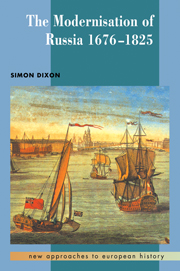Conclusion
Published online by Cambridge University Press: 05 June 2012
Summary
By 1825, educated Russians had stood for so long before the mirror of Western culture, and reinvented themselves so many times in its kaleidoscopic image, that their history may seem to offer more scope to a postmodernist investigation than to one informed by the earthier concerns of modernisation theory. Indeed, at first sight, what is most striking about the modernisation model in the Russian case is its limited applicability. Russia in 1825 was by no means a modern state. Nowhere in Europe was popular participation in politics so severely discouraged; nowhere was subsistence agriculture so widely practised; nowhere did the workings of the world remain so mysterious to so many. Behind the facade of its rationally ordered bureaucratic hierarchy, and beneath the level of the cosmopolitan nobility, the Russian empire remained a peasant society ruled by autocrats who never relinquished their personal grip on the impersonal state authority they were so anxious to develop.
Yet if the Russian experience warns against any simple, linear theory of modernisation, the concept nevertheless helps to bring into focus crucial interrelationships between government, economy, and society. Russia's kinship-dominated peasant communities were not the casual detritus of government-led modernisation: they were its direct consequence. As the state counted the cost of its new standing army, its extensive multi-national territories, its administrative institutions, and its glittering cosmopolitan capital, the people paid the price.
- Type
- Chapter
- Information
- The Modernisation of Russia, 1676–1825 , pp. 256 - 257Publisher: Cambridge University PressPrint publication year: 1999
- 1
- Cited by

